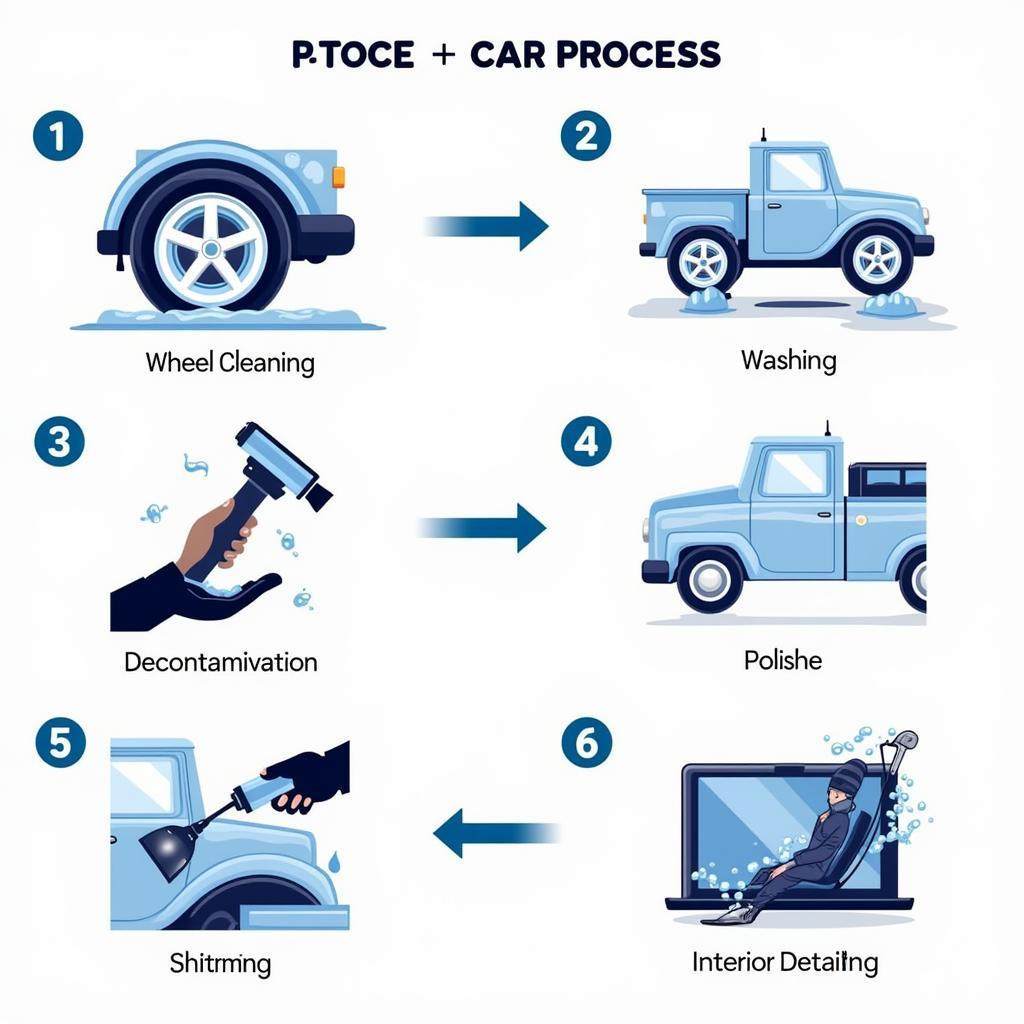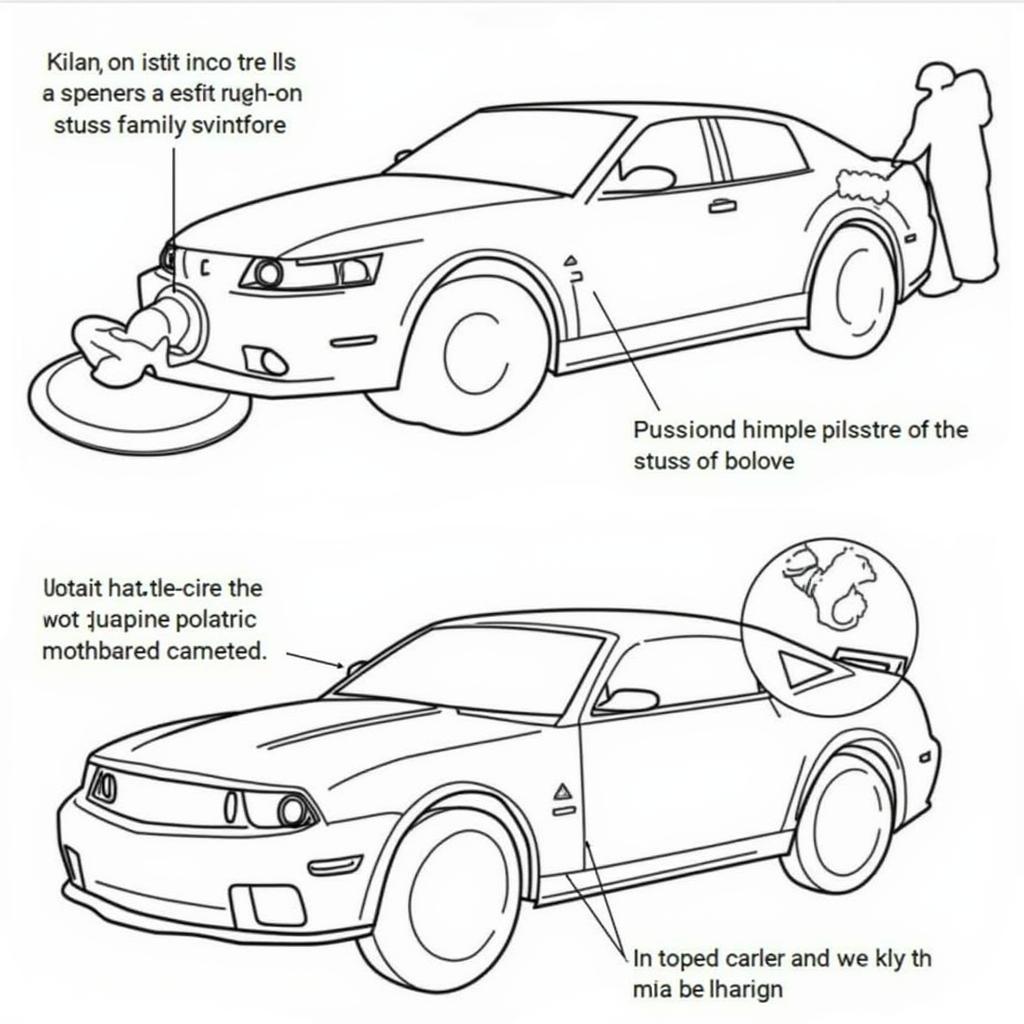Detailing your car is more than just a wash and wax; it’s a meticulous process that restores and protects your vehicle’s finish. Understanding the correct order to detail a car is crucial for achieving professional results and maximizing the effectiveness of each step. This comprehensive guide will walk you through the optimal sequence for detailing your car, ensuring a showroom-worthy shine every time.
After a quick pre-wash, the detailing process starts with cleaning the wheels and tires to prevent cross-contamination. Then, we proceed to the exterior wash, followed by decontamination, polishing, and protecting the paint. Finally, the interior is thoroughly cleaned and protected. This methodical approach guarantees a flawless finish and preserves your car’s value.
 Car Detailing Process Overview
Car Detailing Process Overview
Wheels and Tires: The First Step
Always begin your detailing process with the wheels and tires. They are often the dirtiest part of the car, and cleaning them first prevents grime from splashing back onto a freshly washed car body. Use a dedicated wheel cleaner and tire brush to effectively remove brake dust, road grime, and other contaminants.
Why Start with the Wheels?
Starting with the wheels allows you to thoroughly clean them without worrying about overspray affecting other areas. This is especially important when using stronger cleaning solutions that might harm your paintwork.
Exterior Wash: The Foundation of a Great Detail
Once the wheels are clean, move on to washing the exterior. Use the two-bucket method – one with soapy water and the other with clean rinse water – to minimize the risk of scratching your paint. This method ensures that you’re not reintroducing dirt back onto the car’s surface. A high-quality car wash soap and a microfiber wash mitt are essential for this step. Thorough rinsing is key to removing all traces of soap.
The Two-Bucket Method: Essential for Scratch-Free Washing
The two-bucket method significantly reduces the chances of scratching your paint during the washing process. By frequently rinsing your wash mitt in the clean water bucket, you remove dirt and grit that could otherwise mar your car’s finish.
Do you know how much it costs to detail the interior of a car? Click here to find out: how much does it cost to detail interior of car.
Decontamination: Removing Embedded Contaminants
After washing, your car may still have embedded contaminants that washing alone can’t remove. These include iron particles, tree sap, and industrial fallout. Use a clay bar or iron remover to lift these contaminants, leaving a smooth surface for polishing. This step is crucial for achieving a truly flawless finish.
Polishing: Restoring Paint Perfection
Polishing removes minor scratches and swirl marks, restoring the clarity and depth of your car’s paint. This step requires a polishing machine and appropriate polishing pads and compounds. If you’re new to polishing, consider seeking professional help as improper technique can damage your paint.
 Car Polishing Process
Car Polishing Process
Protection: Sealing in the Shine
After polishing, apply a sealant or wax to protect your car’s paint from the elements and maintain its shine. Sealants typically offer longer-lasting protection than waxes. This final step locks in all your hard work and keeps your car looking its best.
Interior Detailing: A Pristine Cabin
Now that the exterior is complete, move on to the interior. Start by vacuuming the carpets and upholstery, removing all loose dirt and debris. Then, clean and condition all leather and vinyl surfaces. Don’t forget to clean the windows and mirrors for a streak-free finish. Consider how much an interior car detail costs when planning your budget. You might want to find out more about how much does interior car detailing cost. Alternatively, you could check how much does a interior car detail cost. Or, discover how much it costs to get car interior detail.
Conclusion: Maintaining Your Detailed Car
Following the correct order to detail your car is essential for achieving professional results. By starting with the wheels, then moving to the exterior wash, decontamination, polishing, protection, and finally, the interior, you ensure that each step is performed effectively and efficiently, leaving your car looking its best. Regular maintenance, such as washing and waxing, will help preserve the results of your detailing efforts and keep your car looking showroom-worthy for years to come.
FAQ:
- What is the most important step in car detailing? While every step is important, the wash stage is crucial as it sets the foundation for all subsequent steps.
- How often should I detail my car? Ideally, every 3-6 months, depending on usage and environmental factors.
- Can I detail my car myself? Yes, with the right tools and knowledge, you can achieve excellent results.
- What is the difference between a sealant and a wax? Sealants generally offer longer-lasting protection, while waxes provide a warmer, deeper shine.
- What is the two-bucket method? A washing technique that minimizes the risk of scratching your paint.
- Why should I start with the wheels? To prevent dirt and grime from splashing onto the cleaned car body.
- What is the purpose of decontamination? To remove embedded contaminants that washing alone cannot remove.
Thinking about tipping your mobile detailer? Read this: should i tip a mobile car detailing.
Need help with your car detailing? Contact us via WhatsApp: +1(641)206-8880, or Email: [email protected]. We have a 24/7 customer support team ready to assist you.

Leave a Reply